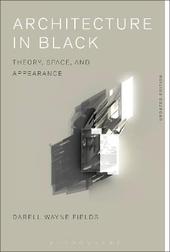
|
Architecture in Black: Theory, Space and Appearance
Hardback
Main Details
| Title |
Architecture in Black: Theory, Space and Appearance
|
| Authors and Contributors |
By (author) Darell Wayne Fields
|
| Physical Properties |
| Format:Hardback | | Pages:232 | | Dimensions(mm): Height 234,Width 156 |
|
| Category/Genre | Theory of architecture |
|---|
| ISBN/Barcode |
9781472567031
|
| Classifications | Dewey:720.1 |
|---|
| Audience | | Professional & Vocational | |
|---|
| Edition |
2nd edition
|
|
Publishing Details |
| Publisher |
Bloomsbury Publishing PLC
|
| Imprint |
Bloomsbury Academic
|
| Publication Date |
12 March 2015 |
| Publication Country |
United Kingdom
|
Description
Based on analysis of historical, philosophical, and semiotic texts, Architecture in Black presents a systematic examination of the theoretical relationship between architecture and blackness. Now updated, this original study draws on a wider range of case studies, highlighting the racial techniques that can legitimize modern historicity, philosophy and architectural theory. Arguing that architecture, as an aesthetic practice, and blackness, as a linguistic practice, operate within the same semiotic paradigm, Darell Fields employs a technique whereby works are related through the repetition and revision of their semiotic structures. Fields reconstructs the genealogy of a black racial subject, represented by the simultaneous reading of a range of canonical texts from Hegel to Saussure to Henry Louis Gates, Jr. Combining an historical survey of racial discourse with new readings resulting from advanced semiotic techniques doubling as spatial arrangements, Architecture in Black is an important contribution to studies of the racial in Western thought and its impact on architecture, space and time.
Author Biography
Darell Wayne Fields is a Lecturer in the College of Environmental Design at the University of California, Berkeley, USA.
ReviewsDarell Field's pioneering book is the first theoretical treatment of race in architecural discourse. The first mature attempt to engage in a sophisticated theoretical discourse about architecture and race using the tools of cultural studies and Afro-American literary theory. In this way, Fields has opened new critical and constructive possibilities for our intellectual discussions of modernity, architecture, and race. -- Cornel West Emerging from a context in which architectural theory increasingly avoids difficult questions, Architecture in Black engages them in a distinctive way. Beginning with a rereading of Hegel's Aesthetics and The Philosophy of History, Fields conjures an encounter between architectural theory and semiotic structures that mines the gaps of history to reconstruct the black subject in a manner that is diagrammatic, projective, and defiantly autonomous and unfixed. Interrogating both history and dialectics to unveil alternative realities, this is an important contribution to the exploration of aporias in architectural theory. -- Jeannie Kim, Assistant Dean of Academic Programming in the John H. Daniels Faculty of Architecture, Landscape, and Design, University of Toronto, Canada A bold and invigorating discussion of the intersection between architecture and race. By excavating the racialized history of architecture, the book opens up new territories for a wider interdisciplinary debate and discussion. An enormously important book. -- Fassil Demissie, Associate Professor of Public Policy Studies, DePaul University, USA and author of 'Colonial Architecture and Urbanism in Africa' It is best to think of this text as an allegorical demonstration of its central thesis: using the critical tools of semiotics, Darell Fields uncovers the black subjectivities hidden with the architectonic structures of Continental Philosophy. Working as the fabled 'trickster' of old, Fields cleverly uses his prose to revise the critical aims of philosophy by constructing a new world from its multiple fragments. While both serious and critical in tone, Architecture in Black is delightfully irreverent in its transformation of the very system it relies upon for existence. The results are both haunting and revelatory. The disembodied voice of its 'Black Subject' is freed of its nineteenth-century prison in time to exert its will upon the projective logic of contemporary architecture. -- Charles Davis, Assistant Professor of Architectural History and Criticism, University of North Carolina Charlotte, USA
|